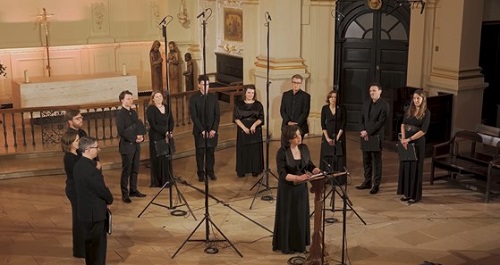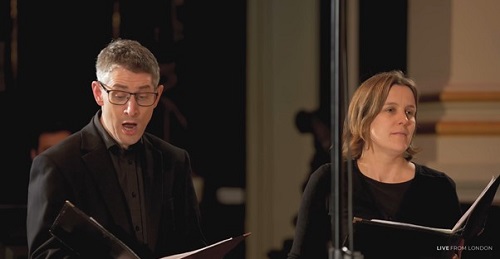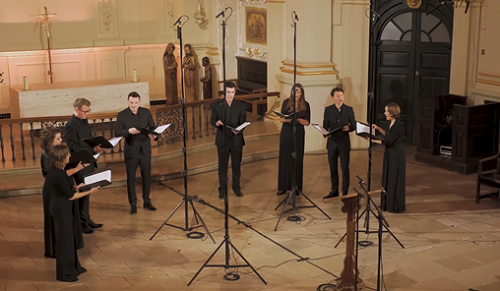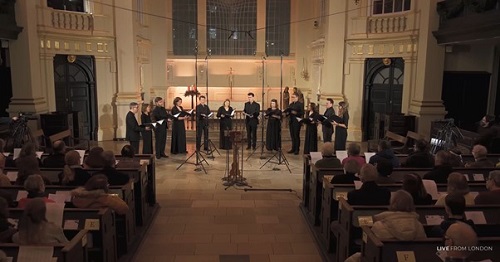Place ‘A Renaissance Christmas’ alongside ‘Stile Antico’ and one might comfortingly anticipate familiar festive fare, immaculately performed. That final expectation was rewardingly fulfilled in this instalment of VOCES8’s Live from London Christmas 2021 digital festival, but there were a few surprises in the mix, as Stile Antico ventured out of the VOCES8 Centre at St Anne and St Agnes in the City of London and travelled a couple of miles south-west to Trafalgar Square in the City of Westminster, where a live audience awaited them inside that familiar landmark nestled into the north-east corner of the square, the Church of St-Martin-in-the-Fields. Some things were customary – not least the polished expressive artistry of Stile Antico and the slick professionalism of VOCES8’s technical team – but this was a ‘service’ of Nine Lessons and Carols with a textual twist, the advent prayers being replaced with Renaissance poems complementing the theme of the musical repertoire.
The plainchant ‘Corde natus ex parentis’ (familiar as ‘Of the Father’s heart begotten’) brought the singers together beneath Shirazeh Houshiary’s elliptical East Window, Will Dawes warm bass inviting other solo voices, dispersed around the nave, to blend in rich, full unison – a heartening unity of strength and joy. Prior to the performance, in a recorded interview with VOCES8’s Chief Executive Officer Paul Smith, members of the ensemble had described the choreographic complexity of the programme as ‘choral ballet’, and it was Cara Curran who stepped forward first to present Aemilia Lanyer’s argument, as spoken by Pilate’s wife, for Adam’s greater culpability for the Fall, ‘Eve’s Apologie in Defence of Women’. It was a fittingly sombre preface – and, as was uniformly the case here, engagingly read – to ‘Remember, O thou man’, a Jacobean ballad by Thomas Ravenscroft, in which the enjambed lines acquired a penitential tone, the need for repentance voiced first with collective conviction and then with polyphonic resolve.

The appeal in Psalm 85 for God to Lord ‘yet once our hartes to joy,/ Show thy grace, thy help employ’, was endorsed by William Byrd’s Advent introit ‘Rorate caeli desuper’, in which the light tone of the ensemble brought a persuasive momentum to the rhythmic gestures, without lessening the comforting choral blend. Individual textual motifs heightened the elegant musical phrasing, and the affirmative ensemble of the ‘Gloria Patri’ conjured a joyful spirit which refused to be subdued by the slightest of broadenings for the tierce de Picardie close.
‘How fresh, O Lord, how sweet and clean/ Are thy returns! ev’n as the flowers in spring’, announces the persona of George Herbert’s ‘The Flower’, rejoicing in a spiritual renewal likened to the resurgence of the spring that follows winter, the seasons both literal and figurative. Such fresh, celebratory sentiment found musical iteration in Michael Praetorius’ well-known carol, ‘Es ist ein Ros entsprungen’. Again, the slightly ‘floating’ quality of the voices and the gentlest staccato articulation created a sense of wonder, and how lovely to hear Melchior Vulpius’ setting of this text for four canonic voices – with its uplifting scalic runs by which the lower voices approach the phrase cadences – embedded within Praetorius’ simple, pure certainty.

In Herbert’s ‘Peace’, an itinerant quester encounters kindness and charity when his needs are met by an elderly reverend who offers him sustenance for his hungry body and stories for his famished soul. Herbert’s allegorical account of the speaker’s search for comfort in Christ found restorative reflection in Peter Philips’ glorious double-choir ‘Hodie nobis de caelo’, in which the four-note falling motif that embodies the peace which has descended from eternity was defiantly buoyant, its joyfulness spilling through the fluid counterpoint like the honey from heaven that distils throughout the world.

The paradoxes of John Donne’s performative address to the Virgin Mary in ‘Annunciation’ – the second sonnet in Donne’s sequence, La Corona, in which he seeks to probe and penetrate the mystery of the Son of God, the Son of Man – were assuaged by the serene sonorities of Josquin des Prez’ ‘Ave Maria’ – ‘Ave cuius conceptio, solemni plena gaudi’ simply shone with holy joy – as Stile Antico traversed the contrasting meters with gently dancing grace. After meekness, magnificence: in the form of Hieronymous Praetorius’ Magnificat quinti toni for two choirs of four voices, sung here with one voice per part but lacking none of the splendour of Praetorius’ polychoral Venetian models. The abundant musical glory was enhanced further by the interpolation of two traditional German carols, ‘Joseph lieber, Joseph mein’ and ‘In dulci iubilo’, within the Magnificat – interruptions that seemed so natural, and enrichening, that it would be easy to believe that this was indeed their rightful musical residence. The vigour and brightness of the eight voices, the floridness of the inner parts, and the unbridled exuberance of this music was truly wonderful to experience.
Such expansiveness was resumed with Thomas Tallis’ Vespers responsory for Candlemas, ‘Videte miraculum’, which opened the second half of the concert, but here the minor key suffused the music with a dense contemplative darkness, the falling phrases seeming to bear the weight of falling tears. Stile Antico made much of the false relations, the tantalising glimpse of the major tonality brightening the restatements of ‘Et matrem’ and the dissonances associated with ‘miraculum’ building in intensity with each repetition, until the smoothness of the ‘Gloria’ brought release.

Donne’s return to the closing image of ‘Annunciation’ – ‘Immensity, cloistered in thy dear womb’ – at the start of his poem, ‘Nativity’, brought the musical story forwards to the birth of Christ, which was celebrated musically by Leo Hassler’s eight-part motet, ‘Hodie Christus natus est’, in which it wasn’t hard to imagine the sheer fluidity and brightness of the Alleluias lifting the audience in St Martin-in-the-Fields up and out of their seats in the Corinthian-pillared nave. Then, the shepherds arrived, courtesy of Henry Vaughan and celebrated by the madrigalian glee of the Ferrarese Raffaella Aleotti in ‘Angelus ad Pastores ait’, in which the rhythmic complexity was almost ‘cheeky’ and the Alleluia delightfully slippery! The wise men were welcomed by an extract from a ‘Christmas Sermon’ by Bishop Lancelot Andrewes, overseer of the translation of the King James Bible, and by ‘A un nino llorando’ by the Sevillian Francisco Guerrero – a villancico (a sort of semi-secular carol) in which the five voices skipped with high-spirited grace.
Robert Southwell’s ‘The Burning Babe’ – the Jesuit writer and missionary’s backwards glance to the medieval image of the Proleptic Passion, which envisions the Christ Child suffering from the wounds of the crucified adult Christ – made for a sombre and intense final Reading, in which the solitary traveller who, ‘shivering in the snow’, encounters the mysterious child ‘Who, scorched with excessive heat, such floods of tears did shed/ As though his floods should quench his flames which with his tears were fed’, hovers on the threshold of the divine. Southwell’s oxymoronic imagery took musical flight in John Sheppard’s radiant setting of St John’s account of the Incarnation, the seven-voice motet ‘Verbum caro factum est’, the expansive range and harmonic freedom of which seemed here – so exuberantly and joyfully sung as it was – to place man himself centre-stage, collapsing the distance between man’s temporality and Christ’s eternity. No wonder Stile Antico looked and sounded so exhilirated.
Claire Seymour
Stile Antico: Helen Ashby, Kate Ashby, Rebecca Hickey (soprano), Emma Ashby, Cara Curran, Rosie Parker (alto), Andrew Griffiths, Jonathan Hanley, Benedict Hymas (tenor), James Arthur, Will Dawes, Nathan Harrison (bass)
A Renaissance Christmas: God tells sinful Adam that he has lost the life of Paradise: Aemilia Lanyer – ‘Eve’s Apologie in defence of women’, Thomas Ravenscroft – ‘Remember O thou man’; God promises abundant blessings to faithful Abraham and his descendants: Psalm 85 from the Sidney Psalter, William Byrd – ‘Rorate caeli’; The prophet foretells the coming of the Saviour: George Herbert – ‘The Flower’, Michael Praetorius – ‘Es ist ein Ros entsprungen’ (Melchior Vulpius, ‘Und hat ein Blümlein bracht’); The peace that Christ will bring is foreshown: George Herbert – ‘Peace’, Peter Philips – ‘Hodie nobis de caelo’; The angel Gabriel salutes the Blessed Virgin Mary: John Donne – ‘Annunciation’, Josquin des Prez – ‘Ave Maria’, Hieronymous Praetorius – Magnificat quinti toni, Thomas Tallis – ‘Videte miraculum’; St Luke tells of the birth of Jesus: John Donne – ‘Nativity’, Hans Leo Hassler – ‘Hodie Christus natus est’; The shepherds go to the manger: Henry Vaughan – ‘The Shepherds’, Raffaella Aleoti – ‘Angelus ad Pastores ait’; The wise men are led by the star to Jesus: Lancelot Andrewes – extract from ‘A Christmas Sermon’, Francisco Guerrero – ‘A un nino llorando’; St John unfolds the great mystery of the Incarnation: Robert Southwell – ‘The Burning Babe’, John Sheppard – ‘Verbum caro factum est’.
St Martin-in-the-Fields, London (live stream); Wednesday 23rd December 2021.